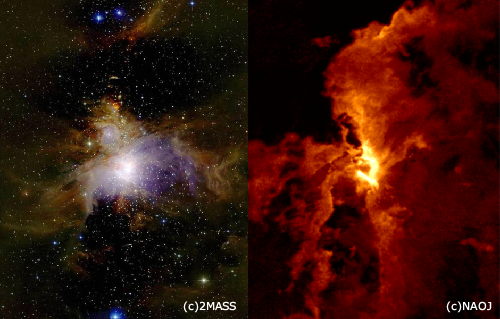Triggered Star Formation in the Orion Molecular Cloud
| Science

(Right) Radio image of Orion molecular cloud. (c) NAOJ
| Science

An international team led by astronomers at the NAOJ Nobeyama has discovered possible triggers of star formation in the Orion molecular cloud.
The Orion molecular cloud is knows as the nearest giant molecular cloud (distance ~ 1300 light years) and one of the most well known parts of the sky where stars are currently being formed. The team carried out extensive high-angular resolution mapping observations toward the Orion molecular cloud using the Nobeyama 45m telescope and the Atacama Submillimeter Telescope Experiment (ASTE, located in Chile).
By investigating the relation between the molecular cloud cores and the surrounding environment, the team has found new possible evidence that the far-ultraviolet (FUV) radiation from massive stars is the trigger for star formation in the Orion molecular cloud (which is called triggered star formation). Triggered star formation is a mechanism where the FUV radiation from massive stars interacts with the surrounding molecular cloud cores, and this interaction triggers star formation. The team believes that triggered star formation is an important astrophysical process related to various types of star formation in the universe. Formation of star clusters and massive stars are few examples where triggered star formation may play a crucial role.